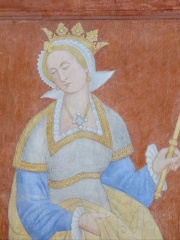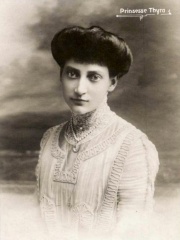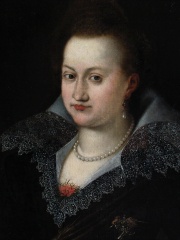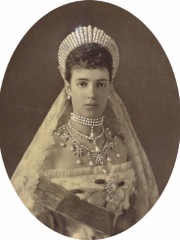

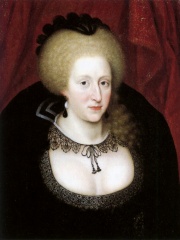
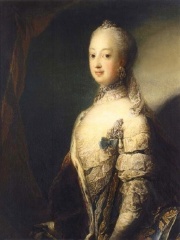
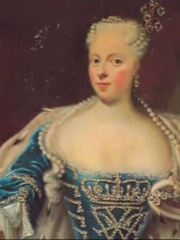
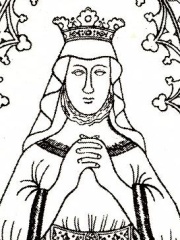
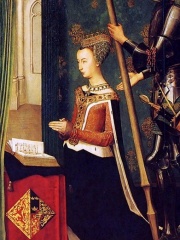
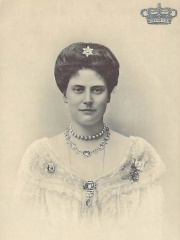
The Most Famous
COMPANIONS from Denmark
This page contains a list of the greatest Danish Companions. The pantheon dataset contains 784 Companions, 20 of which were born in Denmark. This makes Denmark the birth place of the 10th most number of Companions behind Saudi Arabia, and United States.
Top 10
The following people are considered by Pantheon to be the top 10 most legendary Danish Companions of all time. This list of famous Danish Companions is sorted by HPI (Historical Popularity Index), a metric that aggregates information on a biography's online popularity. Visit the rankings page to view the entire list of Danish Companions.

1. Maria Feodorovna (1847 - 1928)
With an HPI of 78.58, Maria Feodorovna is the most famous Danish Companion. Her biography has been translated into 52 different languages on wikipedia.
Maria Feodorovna (Russian: Мария Фёдоровна Романова, romanized: Mariya Fyodorovna Romanova; 26 November 1847 – 13 October 1928), known before her marriage as Princess Dagmar of Denmark, was Empress of Russia from 1881 to 1894 as the wife of Emperor Alexander III. She was the fourth child and second daughter of Christian IX of Denmark and Louise of Hesse-Kassel. Maria’s eldest son, Nicholas, was the last Emperor of Russia, ruling from 1 November 1894 until his abdication on 15 March 1917.

2. Queen Anne-Marie of Greece (b. 1946)
With an HPI of 74.46, Queen Anne-Marie of Greece is the 2nd most famous Danish Companion. Her biography has been translated into 40 different languages.
Anne-Marie (Greek: Άννα-Μαρία, romanized: Ánna-María; born Princess Anne-Marie Dagmar Ingrid of Denmark, 30 August 1946) is a Danish princess who was Queen of Greece as the consort of King Constantine II from their marriage on 18 September 1964 until the abolition of the Greek monarchy on 1 June 1973. Anne-Marie is the youngest daughter of Frederik IX of Denmark and Ingrid of Sweden. In 1964, she married Constantine and became queen consort of Greece. They had five children: Princess Alexia, Crown Prince Pavlos, Prince Nikolaos, Princess Theodora, and Prince Philippos. As queen, Anne-Marie spent much of her time working for a charitable foundation known as "Her Majesty's Fund", a foundation established by her mother-in-law, Queen Frederica of Greece. In 1967, Anne-Marie and her family were forced into exile upon the rise of a military dictatorship. After fleeing to Rome, they eventually settled in London, when the Greek monarchy was officially abolished. Anne-Marie and her family were stripped of their Greek citizenship and had their property revoked, leading them to sue in the European Court of Human Rights. From the compensation she earned, Anne-Marie set up the "Anne-Marie Foundation", which provided assistance to people in rural areas of Greece. In 2013, she and Constantine moved back to Greece. They moved to Athens in 2022, where Constantine died in January the following year.

3. Anne of Denmark (1574 - 1619)
With an HPI of 71.68, Anne of Denmark is the 3rd most famous Danish Companion. Her biography has been translated into 49 different languages.
Anne of Denmark (Danish: Anna; 12 December 1574 – 2 March 1619) was Queen of Scotland from her marriage to James VI and I on 20 August 1589 and Queen of England and Ireland from the union of the Scottish and English crowns on 24 March 1603 until her death in 1619. The second daughter of King Frederick II of Denmark and Sophie of Mecklenburg-Güstrow, Anne married James at age 14. They had three children who survived infancy: Henry Frederick, Prince of Wales, who predeceased his parents; Princess Elizabeth, who became Queen of Bohemia; and James's future successor, Charles I. Anne demonstrated an independent streak and a willingness to use factional Scottish politics in her conflicts with James over the custody of Prince Henry and his treatment of her friend Beatrix Ruthven. Anne appears to have loved James at first, but the couple gradually drifted and eventually lived apart, though mutual respect and a degree of affection survived. In England, Anne shifted her energies from factional politics to patronage of the arts and constructed her own magnificent court, hosting one of the richest cultural salons in Europe. After 1612, she had sustained bouts of ill health and gradually withdrew from the centre of court life. Though she was reported to have been a Protestant at the time of her death, she may have converted to Catholicism at some point. Some historians have dismissed Anne as frivolous and self-indulgent. However, 18th-century writers including Thomas Birch and William Guthrie considered her a woman of "boundless intrigue". Recent reappraisals acknowledge Anne's assertive independence and, in particular, her dynamic significance as a patron of the arts during the Jacobean age.

4. Sophia Magdalena of Denmark (1746 - 1813)
With an HPI of 68.45, Sophia Magdalena of Denmark is the 4th most famous Danish Companion. Her biography has been translated into 32 different languages.
Sophia Magdalena of Denmark (Danish: Sophie Magdalene; Swedish: Sofia Magdalena; 3 July 1746 – 21 August 1813) was Queen of Sweden from 1771 to 1792 as the wife of King Gustav III. Born into the House of Oldenburg, the royal family of Denmark-Norway, Sophia Magdalena was the first daughter of King Frederick V of Denmark and Norway and his first consort, Princess Louise of Great Britain. Already at the age of five, she was betrothed to Gustav, the heir apparent to the throne of Sweden, as part of an attempt to improve the traditionally tense relationship between the two Scandinavian realms. She was subsequently brought up to be the Queen of Sweden, and they married in 1766. In 1771, Sophia's husband ascended to the throne and became King of Sweden, making Sophia Queen of Sweden. Their coronation was on 29 May 1772. The politically arranged marriage was unsuccessful. The desired political consequences for the mutual relations between the two countries did not materialize, and on a personal level the union also proved to be unhappy. Sophia Magdalena was of a quiet and serious nature, and found it difficult to adjust to her husband's pleasure seeking court. She dutifully performed her ceremonial duties but did not care for social life and was most comfortable in quiet surroundings with a few friends. However, she was liked by many in the Caps party, believing she was a symbol of virtue and religion. The relationship between the spouses improved somewhat in the years from 1775 to 1783, but subsequently deteriorated again. After her husband was assassinated in 1792, Sophia Magdalena withdrew from public life, and led a quiet life as dowager queen until her death in 1813.

5. Elizabeth of Denmark, Electress of Brandenburg (1485 - 1555)
With an HPI of 66.76, Elizabeth of Denmark, Electress of Brandenburg is the 5th most famous Danish Companion. Her biography has been translated into 21 different languages.
Elizabeth of Denmark, Norway, and Sweden (24 June 1485 – 10 June 1555) was a Danish princess who became Electress of Brandenburg as the spouse of Joachim I Nestor, Elector of Brandenburg. She was the daughter of King Hans of Denmark, Norway and Sweden and his spouse, Christina of Saxony.

6. Anne Sophie Reventlow (1693 - 1743)
With an HPI of 65.17, Anne Sophie Reventlow is the 6th most famous Danish Companion. Her biography has been translated into 24 different languages.
Anne Sophie von Reventlow (Danish: Anna Sophie; 16 April 1693 – 7 January 1743) was Queen of Denmark and Norway from 1721 to 1730 as the second wife of Frederick IV of Denmark and Norway.

7. Richeza of Denmark (1174 - 1220)
With an HPI of 64.95, Richeza of Denmark is the 7th most famous Danish Companion. Her biography has been translated into 22 different languages.
Rikissa of Denmark (Swedish: Rikissa Valdemarsdotter; died 8 May 1220) was Queen of Sweden as the wife of King Erik Knutsson, and the mother of King Erik Eriksson.

8. Margaret of Denmark, Queen of Scotland (1456 - 1486)
With an HPI of 64.63, Margaret of Denmark, Queen of Scotland is the 8th most famous Danish Companion. Her biography has been translated into 32 different languages.
Margaret of Denmark (23 June 1456 – 14 July 1486) was Queen of Scots from 1469 to 1486 by marriage to King James III. She was the daughter of Christian I, King of Denmark, Norway and Sweden, and Dorothea of Brandenburg.

9. Princess Louise of Denmark (1875 - 1906)
With an HPI of 61.88, Princess Louise of Denmark is the 9th most famous Danish Companion. Her biography has been translated into 25 different languages.
Princess Louise of Denmark (Louise Caroline Josephine Sophie Thyra Olga) (17 February 1875 – 4 April 1906) was a member of the Danish royal family who became a princess of Schaumburg-Lippe by marriage. The third child and oldest daughter of King Frederik VIII and his wife, Queen Louise, Princess Louise grew up in Copenhagen as a Danish princess. Known for her shy and quiet personality, Louise remained a low-key member of the royal family throughout her life. In 1896, she married her second cousin Prince Friedrich of Schaumburg-Lippe who belonged to a cadet branch of the German princely house of Schaumburg-Lippe and was heir to the lordship of Náchod in Bohemia. After the wedding, she moved with him to Bohemia where she died in 1906, aged 31.
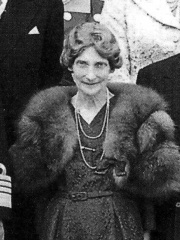
10. Princess Dagmar of Denmark (1890 - 1961)
With an HPI of 61.75, Princess Dagmar of Denmark is the 10th most famous Danish Companion. Her biography has been translated into 23 different languages.
Princess Dagmar of Denmark (Dagmar Louise Elisabeth; 23 May 1890 – 11 October 1961) was a member of the Danish royal family. She was the youngest child and fourth daughter of Frederick VIII of Denmark and his wife, Princess Louise of Sweden and Norway.
People
Pantheon has 20 people classified as Danish companions born between 910 and 1946. Of these 20, 1 (5.00%) of them are still alive today. The most famous living Danish companions include Queen Anne-Marie of Greece. The most famous deceased Danish companions include Maria Feodorovna, Anne of Denmark, and Sophia Magdalena of Denmark.
Living Danish Companions
Go to all RankingsDeceased Danish Companions
Go to all RankingsMaria Feodorovna
1847 - 1928
HPI: 78.58
Anne of Denmark
1574 - 1619
HPI: 71.68
Sophia Magdalena of Denmark
1746 - 1813
HPI: 68.45
Elizabeth of Denmark, Electress of Brandenburg
1485 - 1555
HPI: 66.76
Anne Sophie Reventlow
1693 - 1743
HPI: 65.17
Richeza of Denmark
1174 - 1220
HPI: 64.95
Margaret of Denmark, Queen of Scotland
1456 - 1486
HPI: 64.63
Princess Louise of Denmark
1875 - 1906
HPI: 61.88
Princess Dagmar of Denmark
1890 - 1961
HPI: 61.75
Estrid Svendsdatter
990 - 1073
HPI: 60.94
Princess Thyra of Denmark
1880 - 1945
HPI: 60.78
Hedwig of Denmark
1581 - 1641
HPI: 60.62
Overlapping Lives
Which Companions were alive at the same time? This visualization shows the lifespans of the 8 most globally memorable Companions since 1700.

